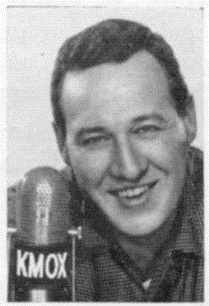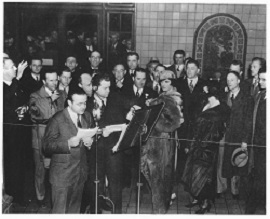Radio Articles
“The Friendly Station” Lives Up to Its Name
Neil Norman, announcer at WIL, once laughingly described the announcer’s booth as “the house by the side of the road” because everyone who comes into the station to visit or to perform passes along there.
“Being a friend to man,” as Walt Whitman described the ideal house along the roadside, is a good idealistic theory, but WIL lives up to it. It is known as “The Friendly Station” and the first thing that greets the visitor’s eyes as he leaves the elevator on the top floor is a sign bearing two hands in a comradely handshake and the slogan “WIL, The Friendly Station.”
On my first visit there, I rather thought that the friendliness that I encountered was because of my connection in radio interests but upon weeks of revisiting it, I am realizing that they really live up to the motto. Everyone from L.A. Benson, president of the station and on down to the janitor who is always in evidence is cordial and it is because they are actually glad to see people and take them into their friendly band.
Evidence enough of the pervading spirit of good fellowship is the fact that no one ever seems to want to leave and one can almost find the entire staff around even when they are not working. They like being with each other. They like extending the expressions of friendship to visitors and they don’t like to leave and fear that they will miss something.
I had the occasion the other day to take a total stranger there while I was securing an interview and the reception he received for no reason at all was of epic-making sincerity.
There was Franklyn MacCormack, the program director, who has a ready smile of greeting and a common interest with everyone who comes up there. He immediately establishes some sort of a definite connection and everyone feels that he has made a friend. While my guest and I were visiting with him, along came six-foot-four-and-a-quarter Billy Lang, who is said to be the tallest announcer in the middle west. He joined the group lending his interest and support to the conversation.
Miss Catherine Snodgrass, who is chief continuity writer and general reception committee stopped by and they all started teasing her while Robert Enoch, leader of the Pirate Club, with his compelling smile and guileless eyes, attempted to take her part. Eddie Wacker with his flaming red hair who was just around joined the general teasing and chatter.
Mr. Benson slipped out of his office with a greeting for everyone and while they paid him the respect due his position, one could feel that he was as much a part of them and their “kidding” as they were themselves. He was in on their secrets and enjoyed the gentle raillery as much as they did.
They treated my guest with such delightful informality that I had all the pleasure of having taken a child to visit his austere maiden aunt and had him behave in a model fashion. The teasing reached its height when Frances Domeimuth, switchboard operator and secretary, handed Franklyn an elaborately wrapped bouquet of flowers from some admirer.
Otto Reinert, director of the studio orchestra, rushed up in his clean white suit with his violin in hand to see what had happened. He joined us rather regretfully for he had been peering in Studio One to try to distract the artist by making faces at him like a bad boy. Even Allister Wylie, pianist, left his dreamy piano musings to come out and talk a minute.
Garnett Marks, newest announcer at the station, sat reading studiously, looking up only occasionally to laugh with the rest of us. Then in strolled several of the five Vaughn Brothers and Les Roberts, soloist. Allen Clarke, who is billed as “The Prince of Songs” rushed out to rehearsal at the Municipal Opera stopping long enough for a handshake and a greeting. C.W. Benson, vise-president, was a friendly but quiet participant in the fun.
We were shown each of the three studios and equipment and went back to the control room where we got the same friendly spirit of interest. We had only stopped for a minute but it was hard to tear ourselves away after an hour’s time for we had gained the feeling that we, too, might miss something.
They accompanied us to the elevator and they had made us know why the station was successful. It couldn’t help but be successful when it is all founded upon such harmony of interest. They work together and love doing it. My guest said as we parted that in all his travels he had never seen such a delightful group of people.
I am an old-timer in my visits there and I know that they are always like that and I agree with my guest. They live up to their motto of: “WIL, The Friendly Station.”
(Originally published in Radio and Entertainment, 7/23/1932).


